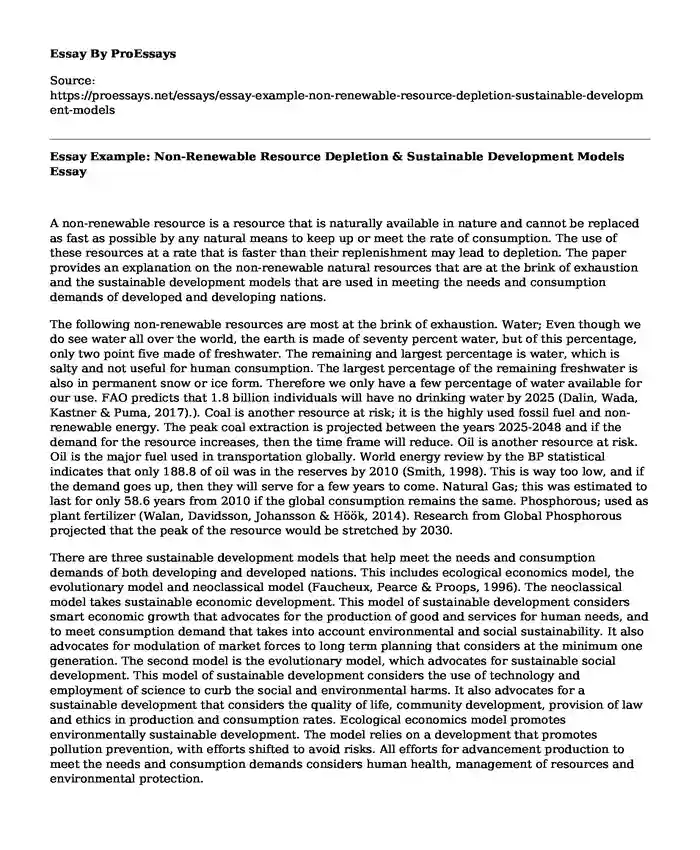A non-renewable resource is a resource that is naturally available in nature and cannot be replaced as fast as possible by any natural means to keep up or meet the rate of consumption. The use of these resources at a rate that is faster than their replenishment may lead to depletion. The paper provides an explanation on the non-renewable natural resources that are at the brink of exhaustion and the sustainable development models that are used in meeting the needs and consumption demands of developed and developing nations.
The following non-renewable resources are most at the brink of exhaustion. Water; Even though we do see water all over the world, the earth is made of seventy percent water, but of this percentage, only two point five made of freshwater. The remaining and largest percentage is water, which is salty and not useful for human consumption. The largest percentage of the remaining freshwater is also in permanent snow or ice form. Therefore we only have a few percentage of water available for our use. FAO predicts that 1.8 billion individuals will have no drinking water by 2025 (Dalin, Wada, Kastner & Puma, 2017).). Coal is another resource at risk; it is the highly used fossil fuel and non-renewable energy. The peak coal extraction is projected between the years 2025-2048 and if the demand for the resource increases, then the time frame will reduce. Oil is another resource at risk. Oil is the major fuel used in transportation globally. World energy review by the BP statistical indicates that only 188.8 of oil was in the reserves by 2010 (Smith, 1998). This is way too low, and if the demand goes up, then they will serve for a few years to come. Natural Gas; this was estimated to last for only 58.6 years from 2010 if the global consumption remains the same. Phosphorous; used as plant fertilizer (Walan, Davidsson, Johansson & Höök, 2014). Research from Global Phosphorous projected that the peak of the resource would be stretched by 2030.
There are three sustainable development models that help meet the needs and consumption demands of both developing and developed nations. This includes ecological economics model, the evolutionary model and neoclassical model (Faucheux, Pearce & Proops, 1996). The neoclassical model takes sustainable economic development. This model of sustainable development considers smart economic growth that advocates for the production of good and services for human needs, and to meet consumption demand that takes into account environmental and social sustainability. It also advocates for modulation of market forces to long term planning that considers at the minimum one generation. The second model is the evolutionary model, which advocates for sustainable social development. This model of sustainable development considers the use of technology and employment of science to curb the social and environmental harms. It also advocates for a sustainable development that considers the quality of life, community development, provision of law and ethics in production and consumption rates. Ecological economics model promotes environmentally sustainable development. The model relies on a development that promotes pollution prevention, with efforts shifted to avoid risks. All efforts for advancement production to meet the needs and consumption demands considers human health, management of resources and environmental protection.
Conclusion
In conclusion, Water, Coal, Phosphorous and Oil are the non-renewable natural resources that are mostly used by human in their daily lives since time immemorial and are at the brink of exhaustion in the near future if not controlled. The need and consumption demands of these resources can be controlled by the three sustainable development models, including ecological economics, evolutionary and neoclassical sustainable development models in both developing and developed countries.
References
Dalin, C., Wada, Y., Kastner, T., & Puma, M. J. (2017). Groundwater depletion embedded in international food trade. Nature, 543(7647), 700-704.
Faucheux, S., Pearce, D., & Proops, J. (1996). Models of sustainable development. Edward Elgar Publishing.
Smith, A. (1998). The 1994 Energy Charter Treaty: EU foreign policy in the field of energy?. The Union and the World: The Political Economy of a Common European Foreign Policy, 247-270.
Walan, P., Davidsson, S., Johansson, S., & Höök, M. (2014). Phosphate rock production and depletion: Regional disaggregated modeling and global implications. Resources, conservation and recycling, 93, 178-187.
Cite this page
Essay Example: Non-Renewable Resource Depletion & Sustainable Development Models. (2023, Oct 30). Retrieved from https://proessays.net/essays/essay-example-non-renewable-resource-depletion-sustainable-development-models
If you are the original author of this essay and no longer wish to have it published on the ProEssays website, please click below to request its removal:
- Human Resources Essay Example on Employment Law
- Chinese Entrepreneurship and Innovation Essay Example
- The Great Depression and Great Recession Essay
- Immigrants and Firms Productivity Essay Example
- Nature vs. Nurture: Unveiling the Impact of Genes on Intelligence - Annotated Bibliography
- COVID-19: Showing Social Safety Net's Weaknesses & Low-Wage Worker Struggles - Essay Sample
- Japanese Yen Crisis - Research Paper Sample







